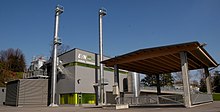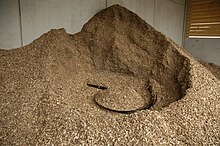Biomass heating plant

A biomass heating plant is a heating plant that uses biomass as fuel . The heat generated is delivered to the customer in the form of hot water or steam via a heating network. In contrast to the biomass power plant and the biomass thermal power plant , no electrical energy is generated.
If the system is in the building to be heated, one speaks, depending on the fuel, e.g. B. wood heating , wood chip heating , pellet heating , etc.
function

A biomass heating plant uses biomass as fuel, but otherwise does not differ in its function from a conventional heating plant . There is a central generation of heat or steam in a heating or steam boiler . Distribution takes place via a local or district heating network . Customers are large residential, commercial, administrative buildings or other consumers with high room heating requirements , process heat requirements (or heat requirements (e.g. swimming pools)). The advantage of central heat supply is that not every household needs its own boiler. Better exhaust gas cleaning is also possible. The high costs and line losses in the heating network are disadvantageous.
Today, biomass heating plants are mostly built for the output range from 300 to 20,000 kW, and have a fossil -fired failure and peak load reserve boiler to cover the load peaks for reserve purposes. Larger systems, i.e. with a total output of approx. 10,000 kW or more, are preferably built as (biomass) thermal power stations in which a combined generation of electricity and heat takes place through combined heat and power .
A biomass heating plant always has its own structure and generally consists of the following system parts:
Fuel storage, fuel transport device (e.g. thick matter pump , moving floor , screw conveyor , trough chain conveyor ), boiler loading, combustion or fire chamber, heat exchanger , flue gas cleaning cyclone , electrostatic precipitator , chimney , ash removal and ash container.
Fuels

Frequently used fuels are sawdust, sawdust, bark, wood chips , untreated residual wood and / or pellets .
The use of bioenergy , such as B. Heat from biomass heating plants is promoted by laws such as the Renewable Energies Heat Act (EEWG), as it has ecological advantages, among other things. (see main article bioenergy and climate neutrality )
The use of forest chips is being discussed in part, as this would increase the use of the forest ecosystem and thus the deprivation of nutrients. In biomass heating plants, however, wood chips represent only part of the fuel.
Historical development
Biomass heating plants have been newly built in the past two decades. At the end of the 1980s, the use of firewood decreased, as the fully automatic heat supply with oil and gas heating was much more convenient. In order to enable the use of wood, individual provincial governments in Austria began to promote the expansion of district heating. The pioneer here was the federal state of Salzburg , and so the first biomass heating plants with district heating were built in Lofer , Lamprechtshausen , Bramberg am Wildkogel etc. before / around 1990. Later, other governments such as Lower Austria or Bavaria also created an economic basis through investment subsidies, so that in the aforementioned federal states by the year 2000 numerous systems were built.
From the year 2000 the governments of the European Union began to promote the expansion of the use of biomass. Today state subsidies for the construction of biomass heating plants amounting to up to 30% of the investments are common. In Austria, for example, more than 1000 biomass heating plants with a boiler output of more than 500 kW have been built since then, some of which supply entire towns and some only industrial companies with heat.
Current state

Biomass heating plants are now being built with a biogenic output range between 300 kW and 5 MW. Smaller units are usually set up in the heat-consuming object, while larger units usually generate both electricity and heat as biomass thermal power stations. The further development of the Organic Rankine Cycle Process (ORC) can make electricity generation in heating plants (thermal power plants) economical.
The generation of electricity in biomass cogeneration plants is promoted under the Renewable Energy Sources Act (EEG). In particular, systems with low output receive a premium on electricity that is fed into the grid.
In Germany there are more than 1200 biomass heating plants with a thermal output of more than 500 kW. The total bioheat from solid biomass in 2009 amounted to 95 TWh or 7% of the total market in the heating sector, whereby the market share had almost doubled within the previous five years.
Individual evidence
- ↑ Biomass heating plant with a total output of 22 MW
- ↑ Biomass CHP with ORC technology, conference lecture 2006 (PDF; 1.5 MB)
- ↑ Full text of the EEG 2014
- ↑ The bioenergy market in figures 2009; Bundesverband Bioenergie eV as of October 1st, 2010
- ↑ heating sector; Bundesverband Bioenergie eV as of October 1st, 2010
- ↑ Renewable Energy in Figures ( Memento of the original from December 15, 2011 in the Internet Archive ) Info: The archive link was automatically inserted and has not yet been checked. Please check the original and archive link according to the instructions and then remove this notice. (PDF; 2.9 MB) Status: October 1, 2010
literature
- Working group quality management for wood heating plants for Switzerland, Germany, Austria. : Planning manual (for biomass heating plants) . ISBN 3-937441-94-8
- Ten-year anniversary of the Gföhl biomass heating plant As of February 22, 2009
- Hermann Stockinger, Ingwald Obernberger; System analysis of the local heating supply with biomass . ISBN 978-3-9501980-1-0 .
- Agency for Renewable Resources eV : Guide bioenergy - planning, operation and economics of bioenergy plants , Gülzow (2005), second, revised edition, ISBN 3-00-015389-6 , as a PDF file available
